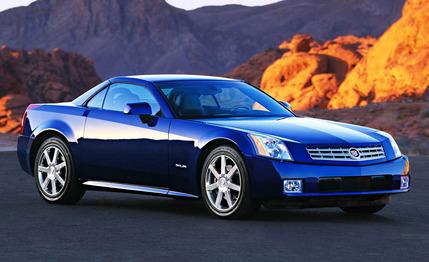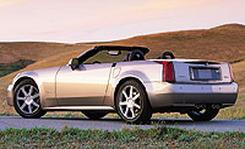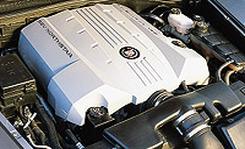
 First Drive Review
First Drive Review
Cadillac's long-range product plan calls for social climbing on a scale that would have impressed a certain Argentine harlot named Eva. In short, the company wants to sell really expensive cars that both young and old people would kill to own, as was the case in the early days of this century-old brand. If the V-16 show car we scooped the competition with last month suggests Cadillac's destination, the journey will start with this $75,000 XLR roadster, due in stores in May 2003.
Yes, Cadillac tried to climb this rung of the prestige ladder once before, in 1987. Remember the Allanté? Accounting for inflation, it cost just as much as this XLR when it departed the scene in 1993, a sales flop that failed to elevate Cadillac's image. But whereas that car relied on Pininfarina styling and a transatlantic jet ride to overcome its unsuitable front-wheel drivetrain and subpar build quality, this one promises to be fully baked -- the real deal.
That promise hangs on a platform shared with the next-generation Corvette, borrowing that car's basic control-arm and transverse-leaf-spring architecture, plus its Magnetic Ride Control shocks, although the geometry and tuning are tailored to suit Cadillac's less track-oriented mission. Wheel travel, for example, is increased 0.4 inch in front, 0.8 inch in back. The rear wheels slide almost an inch rearward to accommodate a longer transaxle, and the front axle moves forward 0.2 inch on a deeper aluminum subframe capable of cradling the taller, longer Northstar engine.


That familiar four-cam motor boasts 80-percent new parts, but conspicuously absent among them is the Eaton supercharger that helped produce 405 horsepower -- evocative of the ZR-1 Corvette -- in the XLR's progenitor, the Evoq show car. All chief engineer Dave Leone had to say about the blower was: "We're looking at it for future applications." Many of the revised parts were needed to reorient the engine for rear-wheel drive, but the new Northstar gets continuously variable intake- and exhaust-valve timing, larger exhaust valves, new heads, and a 10.5:1 compression ratio (up from 10.0:1). These bits elevate output to "well above 300 horsepower and 300 pound-feet." To reduce noise and vibration, all accessories now mount directly to the block, and Cadillac promises the power delivery will be more refined and linear than a Corvette's, with an emphasis on confident passing rather than drag racing.


Given that emphasis, it probably won't shock anyone to learn that a manual transmission is not planned. The 5L50-E tranny (a beefed-up version of the CTS's 5L40 box) does offer a manumatic shifter gate and Cadillac's excellent Performance Algorithm Shifting system to delay upshifts while cornering, braking, or climbing hills. It's mated to the same Getrag limited-slip differential as found under the Corvette but with a 2.93:1 ratio.
Like the Corvette, the XLR will be sheathed in composite bodywork, although the fiberglass is now thicker (3.0 millimeters, up from 2.25). New induction-heated molds, robotic parts handling, and laying the painted parts flat for curing should endow the XLR with a mirror-smooth finish.
Unlike the Vette, the XLR gets a retractable hardtop, which accounts for a good bit of its price premium. The clamshell design was engineered by Germany's Car Top Systems, the folks who bring you the Mercedes SLK and SL tops. To lower the roof, raise a luggage divider partition in the trunk and press a button. The decklid powers open (in the same front-hinged manner as for trunk access), the header latches release, the quarter-windows fold inward along their C-pillar hinges, the top folds in half along the top of the rear window and stows, consuming the front 60 percent of the 12-cubic-foot trunk. A tonneau panel swings out from under the decklid as it closes on five cubic feet of lightly packed garment-bag stowage space.
Cadillac claims the XLR's smooth 0.31-Cd shape ensures that the cockpit will be conversationally calm without any wind-blocking screens or panels. We are also assured that the Bvlgari-designed instruments and the DVD-based navigation screen remain legible in direct sunlight. Nearly everything you touch in the XLR is made of genuine metal, cow, or eucalyptus tree. It's also soft to the touch, if techno hard-edged in appearance. The seats are heated, cooled, and stereophonic -- two Bose speakers point up at the occupants' ears from the seats' "shoulders." Storage nooks and bins abound.
Few of the Evoq's Futurama TV cameras and gadgets made the cut in the XLR, but keyless entry and starting are keepers. One has only to carry the stylish Bvlgari fob in a purse or pocket and place a finger on the microswitch inside the opening behind either door, and -- voilà! -- the door unlocks and opens. Sit down, step on the brake, and press the start button. Shutting down and getting out is also a pushbutton affair, and manual releases on the sills and in the trunk permit entry or exit if the power goes out.
Does the XLR have the legs for the kind of social climbing Cadillac is attempting here? Given its 50/50 weight distribution, a power-to-weight ratio that splits the difference between Mercedes' SL500 and SL55 roadsters, and a respected chassis pedigree, its prospects look good to us. Of course, a supercharged XLR would have us singing Santa Evita!